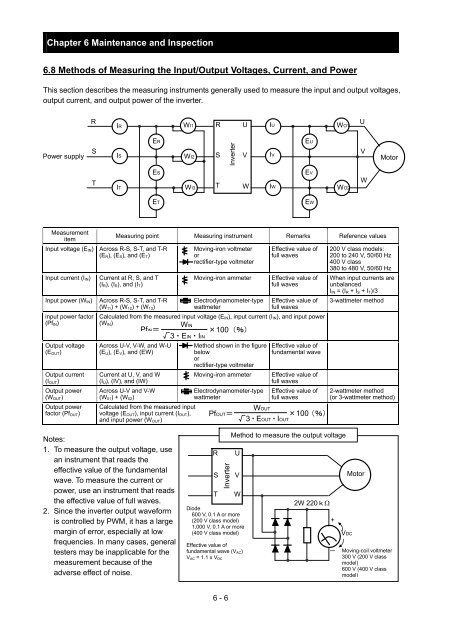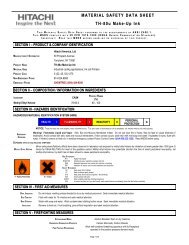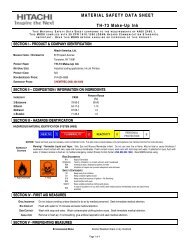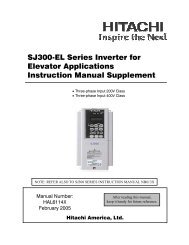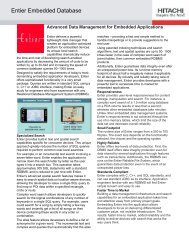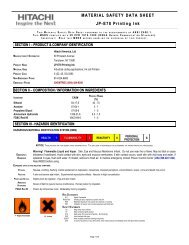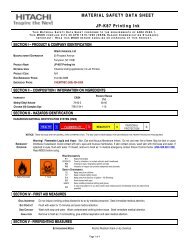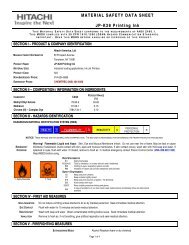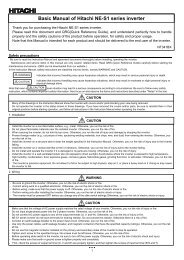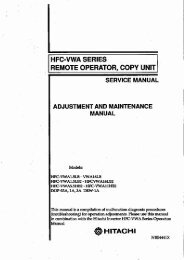SJ700-2 Instruction Manual NT204DX - Hitachi America, Ltd.
SJ700-2 Instruction Manual NT204DX - Hitachi America, Ltd.
SJ700-2 Instruction Manual NT204DX - Hitachi America, Ltd.
Create successful ePaper yourself
Turn your PDF publications into a flip-book with our unique Google optimized e-Paper software.
Chapter 6 Maintenance and Inspection<br />
6.8 Methods of Measuring the Input/Output Voltages, Current, and Power<br />
This section describes the measuring instruments generally used to measure the input and output voltages,<br />
output current, and output power of the inverter.<br />
R<br />
IR<br />
WI1<br />
R<br />
U<br />
IU<br />
WO1<br />
U<br />
Power supply<br />
S<br />
IS<br />
ER<br />
WI2<br />
S<br />
Inverter<br />
V<br />
IV<br />
EU<br />
V<br />
Motor<br />
T<br />
IT<br />
ES<br />
WI3<br />
T<br />
W<br />
IW<br />
EV<br />
WO2<br />
W<br />
ET<br />
EW<br />
Measurement<br />
item<br />
Input voltage (E IN ) Across R-S, S-T, and T-R<br />
(E R ), (E S ), and (E T )<br />
Input current (I IN )<br />
Input power (W IN )<br />
input power factor<br />
(Pf IN )<br />
Output voltage<br />
(E OUT )<br />
Output current<br />
(I OUT )<br />
Output power<br />
(W OUT )<br />
Output power<br />
factor (Pf OUT )<br />
Measuring point Measuring instrument Remarks Reference values<br />
Current at R, S, and T<br />
(I R ), (I S ), and (I T )<br />
Across R-S, S-T, and T-R<br />
(W 11 ) + (W 12 ) + (W 13 )<br />
Moving-iron voltmeter<br />
or<br />
rectifier-type voltmeter<br />
Moving-iron ammeter<br />
Electrodynamometer-type<br />
wattmeter<br />
Effective value of<br />
full waves<br />
Effective value of<br />
full waves<br />
Effective value of<br />
full waves<br />
Calculated from the measured input voltage (E IN ), input current (I IN ), and input power<br />
(W IN )<br />
WIN<br />
PfIN=<br />
Across U-V, V-W, and W-U<br />
(E U ), (E V ), and (EW)<br />
Current at U, V, and W<br />
(I U ), (IV), and (IW)<br />
Across U-V and V-W<br />
(W 01 ) + (W 02 )<br />
√3・EIN・IIN<br />
Calculated from the measured input<br />
voltage (E OUT ), input current (I OUT ),<br />
and input power (W OUT )<br />
×100(%)<br />
Method shown in the figure<br />
below<br />
or<br />
rectifier-type voltmeter<br />
Moving-iron ammeter<br />
Electrodynamometer-type<br />
wattmeter<br />
PfOUT=<br />
WOUT<br />
Effective value of<br />
fundamental wave<br />
Effective value of<br />
full waves<br />
Effective value of<br />
full waves<br />
×100(%)<br />
√3・EOUT・IOUT<br />
200 V class models:<br />
200 to 240 V, 50/60 Hz<br />
400 V class<br />
380 to 480 V, 50/60 Hz<br />
When input currents are<br />
unbalanced<br />
I IN = (I R + I S + I T )/3<br />
3-wattmeter method<br />
2-wattmeter method<br />
(or 3-wattmeter method)<br />
Notes:<br />
1. To measure the output voltage, use<br />
an instrument that reads the<br />
effective value of the fundamental<br />
wave. To measure the current or<br />
power, use an instrument that reads<br />
the effective value of full waves.<br />
2. Since the inverter output waveform<br />
is controlled by PWM, it has a large<br />
margin of error, especially at low<br />
frequencies. In many cases, general<br />
testers may be inapplicable for the<br />
measurement because of the<br />
adverse effect of noise.<br />
R<br />
S<br />
T<br />
Inverter<br />
Method to measure the output voltage<br />
U<br />
V<br />
W<br />
Diode<br />
600 V, 0.1 A or more<br />
(200 V class model)<br />
1,000 V, 0.1 A or more<br />
(400 V class model)<br />
Effective value of<br />
fundamental wave (V AC )<br />
V AC = 1.1 x V DC<br />
2W 220kΩ<br />
+<br />
-<br />
VDC<br />
Motor<br />
Moving-coil voltmeter<br />
300 V (200 V class<br />
model)<br />
600 V (400 V class<br />
model)<br />
6 - 6


